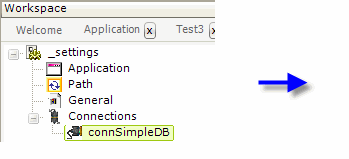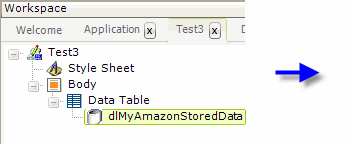Data Layer.Simple DB
Amazon.com offers an online, distributed data storage environment, called SimpleDB. For developers who wish to work with Amazon Web Services' SimpleDB "database" facilities, Logi Info now offers the DataLayer.SimpleDB element. This topic discusses this datalayer.
- Attributes
- Work with DataLayer.SimpleDB
![]() Amazon publishes general information about Amazon Web Services (AWS) SimpleDB, requires users to have an AWS account, and charges for their storage service. DataLayer.SimpleDBis not available for Logi Report.
Amazon publishes general information about Amazon Web Services (AWS) SimpleDB, requires users to have an AWS account, and charges for their storage service. DataLayer.SimpleDBis not available for Logi Report.
Attributes
The DataLayer.SimpleDB element has the following attributes:
| Attribute | Description |
|---|---|
Connection ID | (Required) Specifies the ID of a Connection.SimpleDB element in the application's _Settings definition. This element is discussed in more detail in the next section. |
| ID | (Required through v10.1.46) A unique element ID. |
| Maximum Rows | Specifies a the maximum number of data rows to retrieve. If left blank, then all records that satisfy the query in the SimpleDB Query attribute will be retrieved. |
| SimpleDB Domain | (Required) Specifies the SimpleDB domain (similar to a database table) to query. |
SimpleDB Query | Specifies the query to be used to retrieve data. If left blank, then all records will be retrieved (up to any limit specified in the Maximum Rows attribute). Amazon SimpleDB provides a simple custom query language for searching stored data. |
Working with DataLayer.SimpleDB
In most respects, DataLayer.SimpleDB functions exactly as other datalayer elements do and its data can be filtered and conditioned using appropriate child elements. Like other datalayers, it works with a specific Connection element, Connection.SimpleDB, to connect to the Amazon web service.


As shown above, the Connection.SimpleDB element is added to the _settings definition, beneath the Connections element. Its SimpleDB Access Key and SimpleDB Secret Access Key attribute values are set to match those of your Amazon Web Services account. Note that the Secret Access Key attribute will be encrypted by the Connection element before being sent over the Internet.


Next, in the report definition, a DataLayer.SimpleDB element is added as a child element of a data table or another data container element. Its attributes are set so that it accesses the desired SimpleDB connection and queries the desired domain (table) using the desired query.
The datalayer reads and caches the data from the SimpleDB web service. You can add child elements beneath the datalayer to affect its contents, including:
- Filtering: Sort, group, or restrict the data
- Extending: Add virtual columns to the datalayer that contain aggregated, calculated, or totaled data values
- Securing: Limit access to the data using Logi security
- Linking: Make the results reusable elsewhere in your report definitions
The use of many of these elements is described in separate DevNet documents.
Data read into the datalayer is cached in XML format in memory and/or on the web server's file system. The latter is discussed in The Logi Server Engine and may be of interest to developers working with extremely large datasets or large numbers of concurrent users.
The data read with the datalayer is available using @Datatokens, in the format @Data.ColumnName~. The spelling of the column name is case-sensitive. The data is only available within the scope of the parent element of the datalayer, not throughout the entire report definition. The DataLayer.Linked element can be used to make the data reusable in another datalayer outside this scope.
The data retrieved into the datalayer can be viewed by turning on the Debugging Link in your _settings definition (General element) and using the resulting link at the bottom of your report page to view the Application Trace page. A link on the Trace Page will display the retrieved data.